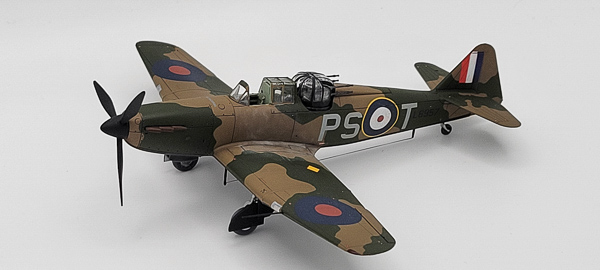
Airfix 1/72 Boulton Paul Defiant Mk I
By Chris Banyai-Riepl
Overview
The Boulton Paul Defiant arose from the idea that German bombers would not be able to have fighter escort over England, which led to the design of a bomber interceptor aircraft that could easily attack bombers with highly concentrated firepower. This was achieved through a quad-gun turret that could direct its firepower from the side or beneath bombers. The presence of Luftwaffe fighter escorts over England quickly forced the withdrawal of the Defiant from frontline service, but it saw continued action as a night fighter and later, as a target tug, before finally being relegated to testing aircraft by 1944.

|

|
Enhancing the Airfix Kit
The new-tool (ish, released back in 2014) Airfix 1/72 Defiant is a solid kit out of the box, with a reasonably detailed interior and solid engineering. There’s plenty of room for improvement, though, and with the addition some Eduard pre-painted photoetch and Master brass gun barrels & pitot tube, plus an Xtradecal aftermarket decal sheet, I was set to tackle my Defiant build.

|

|
With all the extra stuff in hand, the first step is to dive into the interior. I sprayed all the kit parts with Vallejo British interior green, and then started applying the Eduard photoetch details. It was here that the first challenge showed up, as the interior green parts in the Eduard photoetch was nowhere near the same color as the Vallejo paint. Luckily those few parts that color were easily touched up, so after some paintwork and some washes, plus adding the Master barrels to the turret assembly, the interior details were finished.

|

|
With the cockpit done, assembly was next and this went surprisingly well. With just a bit of care on potential seams, the whole build went very well, with no major filler needed. With the photoetch interior in place, I had decided to go with an open cockpit, and the Airfix kit has that covered with two different versions of canopies. Setting up the right options for those, the next essential step that I hadn’t mentioned was masking these off. Anyone who builds this kit and doesn’t get the Eduard pre-cut masks for it is just asking for trouble. Between the multiple frames on the forward canopy and the extensive greenhouse for the turret, these pre-cut masks are an absolute life saver.

|

|
Speaking of masks, after doing a couple different shades of dark gray and black on the underside, I had to think of the upper surface camouflage. As an experiment, I decided to try creating my own masks for the upper surface camouflage, so after painting the base dark earth, I started planning. I drew up the proper pattern in Adobe Illustrator and sent that file to a Brother Scan-n-Cut DX cutter. I used a sheet of Tamiya masking tape and cut out the patterns. I didn’t have the settings quite right so instead of cutting through just the tape, it cut through the backing paper as well, but the shapes were good and I was able to mask everything off and paint the dark green. A gloss coat and it was time for decals.

|

|
I had wanted to do a Defiant with roundels on the undersurface, which the kit options did not have. So I turned to one of the Xtradecal sheets that had that as an option, PS-T from 264 Squadron in late May, early June 1940. The Xtradecal decals went on beautifully, and I supplemented those with the stencil and detail decals from the Airfix kit. With all those decals in place, this build was looking really good, so it was on to the final steps.

|

|
Those final steps included adding the landing gear, prop, and exhausts, as well as the under-fuselage antenna. I kept the weathering to a minimum, as these were not heavily used aircraft at this point, so a bit of dirt & grime at the wing root & cockpit area was about it for the weathering. Adding a wire on the underside and the Master wing pitot and I called this one done.

|

|
Conclusion
This was a fun build that allowed me to play around with some new ideas in creating my own masks, as well as working with photoetch and other aftermarket bits. I am now looking forward trying my hand at other potential masking ideas, such as national insignias and codes & serials.

|

|
